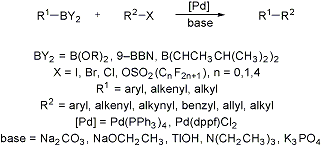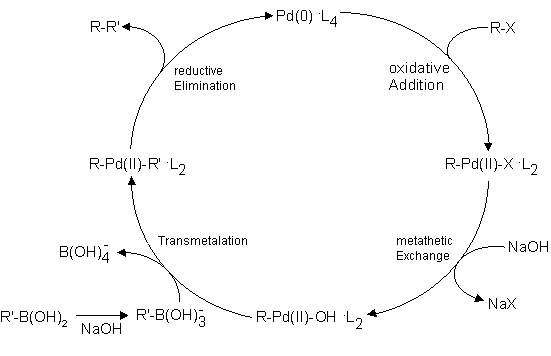(Chief Bee)
05-18-03 10:37
No 433965
(Rated as: excellent)
Arylboronic acids [Ar-B(OH)2] are very useful precursors used in Pd-catalyzed Suzuki Couplings, where almost any organic halide can be coupled with an arylboronic acid, one example being that allyl bromide would give allylbenzenes.

General procedure for arylboronic acid synthesis1
Magnesium turnings (30 mmol) were placed in a round-bottomed flask and then flame-dried under N2. Aryl bromide (30 mmol) dissolved in THF (20 mL) was added with an addition funnel to the flask slowly. The reaction mixture was gently refluxed for 3 to 4 h. After cooling, the Grignard reagent was transferred to a solution of (CH3O)3B in THF (10 mL) at -78°C and stirred overnight while warming up to RT slowly. After acidification with 10% HCl (10 mL), the product was extracted into ether (3x100 mL) and dried (sodium sulfate). The solvent was then removed under reduced pressure, and the products was precipitated by hexane with further recrystallization from water.
p-Tolylboronic acid: white needles were obtained in 81% yield; mp 243-244°C (lit.2 242-243°C).
p-Methoxyphenylboronic acid: White needles were obtained in 72% yield; mp 197-198°C (lit.2 202-205°C).
Arylboronic Acid References:
[1]: Tetrahedron 51(11), 3129 (1995)
[2]: J. Am. Chem. Soc. 53, 711 (1931)
Suzuki Coupling
In this reaction is a bromo compound R-Br coupled to a boronic acid R'-B(OH)2 with Pd-catalyst. In the first step the bromo compound is added oxidative at Pd(0) and the bomide is metathetically substituted by an hydroxy ion. After trans-metallation and secession of tetrahydroxyborate the Pd(II) with both organic moieties is obtained. The Pd is reductively eliminated and the residues coupled to R-R'.

Suzuki Coupling References:
http://themerckindex.cambridgesoft.com/T
http://www.chempensoftware.com/reactions
http://www.mdpi.net/ecsoc-5/e0029/e0029.
http://www.sigmaaldrich.com/img/assets/3
(Hive Addict)
05-19-03 17:30
No 434235
why not just use the protected aminoalkylhalide to directly produce amphetamine or meth?
(Hive Addict)
05-20-03 02:49
No 434305
These catalysts are recomended by the catalyst manufacturers;
trans-PdCl2(CH3CN)2
Pd(PPh3)4
Bedford's acetate
Bedford's chloride
[Pd(OAc)2]3
Polymer supported Pd(PPh3)4 is used in the industry today because it has the advantages of a heterogenous catalysts (easy removal by filtration) combined with the properties of the homogenous catalyst (better utilisisation of the metal, elimination of in-pore diffusion, easy exotherm control).
Freaky
(Chief Bee)
05-20-03 13:48
No 434390
why not just use the protected aminoalkylhalide to directly produce amphetamine or meth?
That is of course possible, I didn't mention any such halide specifically, as I am not 100% sure exactly which protecting groups are compatible with Suzuki Chemistry. Also, allylbromide given as example in my post has a history of giving very high yields in coupling reactions, while other more complex halides may have unpredictable yields.
(Hive Addict)
05-20-03 14:03
No 434393
Good point on the yields comment. However, what kind of yields could be acheived overall through each route? Do you have any more references for this type of coupling?
(Chief Bee)
05-20-03 15:11
No 434400
Suzuki couplings can be close to quantitative in some cases (where degassed solvents, inert atmosphere, fancy Pd ligands and reactive substrates are used), but expect good yields, as in 75%+ or so for non-problematic substrates.
Below are two Suzuki couplings I have posted here earlier, I'm sure you can find more using TFSE, and if you search for "suzuki coupling" or "suzuki reaction" using Google, you'll find a lot of articles on the topic.
Post 320892 (Rhodium: "Allylbenzenes by Suzuki Coupling", Novel Discourse)
Post 405016 (Rhodium: "Pd-catalyzed Suzuki synth of phenylacetamides", Novel Discourse)
(Hive Addict)
05-20-03 21:10
No 434490
Just so you know, I wasn't trying to opt-out on using the search engine. The reason I asked is that it's easier to find materials relevant to our cause if I ask you first. The articles in general I can find pretty easily.
Thanks for the help though- very informative.
(Chief Bee)
05-21-03 04:58
No 434536
(Rated as: excellent)
No hard feelings, I merely thought that you might find more info on google than from me, my palladium coupling chem knowledge could be a lot better than it is.
I found a few review articles about Suzuki Chemistry today:
Chem. Rev. 95, 2457 (1995) (../rhodium/pdf /pd-cat.cross
J. Organomet. Chem. 576, 147 (1999) (../rhodium/pdf /suzuki.cross
Chem. Rev. 102, 1359 (2002) (../rhodium/pdf /aryl-aryl.bo
(Hive Addict)
05-21-03 13:44
No 434612
Don't worry about offense, I take all of your comments seriously as you have nothing to prove to me. (My knowledge of chemistry in general could use some work.)
And thanks! those are great links.